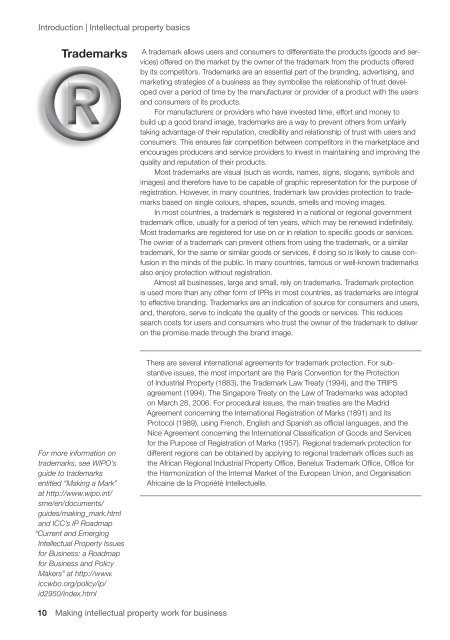Making intellectual property work for business - World Intellectual ...
Making intellectual property work for business - World Intellectual ...
Making intellectual property work for business - World Intellectual ...
Create successful ePaper yourself
Turn your PDF publications into a flip-book with our unique Google optimized e-Paper software.
Introduction | <strong>Intellectual</strong> <strong>property</strong> basics<br />
Trademarks<br />
For more in<strong>for</strong>mation on<br />
trademarks, see WIPO’s<br />
guide to trademarks<br />
entitled “<strong>Making</strong> a Mark”<br />
at http://www.wipo.int/<br />
sme/en/documents/<br />
guides/making_mark.html<br />
and ICC’s IP Roadmap<br />
“Current and Emerging<br />
<strong>Intellectual</strong> Property Issues<br />
<strong>for</strong> Business: a Roadmap<br />
<strong>for</strong> Business and Policy<br />
Makers” at http://www.<br />
iccwbo.org/policy/ip/<br />
id2950/index.html<br />
10 <strong>Making</strong> <strong>intellectual</strong> <strong>property</strong> <strong>work</strong> <strong>for</strong> <strong>business</strong><br />
A trademark allows users and consumers to differentiate the products (goods and services)<br />
offered on the market by the owner of the trademark from the products offered<br />
by its competitors. Trademarks are an essential part of the branding, advertising, and<br />
marketing strategies of a <strong>business</strong> as they symbolise the relationship of trust developed<br />
over a period of time by the manufacturer or provider of a product with the users<br />
and consumers of its products.<br />
For manufacturers or providers who have invested time, ef<strong>for</strong>t and money to<br />
build up a good brand image, trademarks are a way to prevent others from unfairly<br />
taking advantage of their reputation, credibility and relationship of trust with users and<br />
consumers. This ensures fair competition between competitors in the marketplace and<br />
encourages producers and service providers to invest in maintaining and improving the<br />
quality and reputation of their products.<br />
Most trademarks are visual (such as words, names, signs, slogans, symbols and<br />
images) and there<strong>for</strong>e have to be capable of graphic representation <strong>for</strong> the purpose of<br />
registration. However, in many countries, trademark law provides protection to trademarks<br />
based on single colours, shapes, sounds, smells and moving images.<br />
In most countries, a trademark is registered in a national or regional government<br />
trademark office, usually <strong>for</strong> a period of ten years, which may be renewed indefinitely.<br />
Most trademarks are registered <strong>for</strong> use on or in relation to specific goods or services.<br />
The owner of a trademark can prevent others from using the trademark, or a similar<br />
trademark, <strong>for</strong> the same or similar goods or services, if doing so is likely to cause confusion<br />
in the minds of the public. In many countries, famous or well-known trademarks<br />
also enjoy protection without registration.<br />
Almost all <strong>business</strong>es, large and small, rely on trademarks. Trademark protection<br />
is used more than any other <strong>for</strong>m of IPRs in most countries, as trademarks are integral<br />
to effective branding. Trademarks are an indication of source <strong>for</strong> consumers and users,<br />
and, there<strong>for</strong>e, serve to indicate the quality of the goods or services. This reduces<br />
search costs <strong>for</strong> users and consumers who trust the owner of the trademark to deliver<br />
on the promise made through the brand image.<br />
There are several international agreements <strong>for</strong> trademark protection. For substantive<br />
issues, the most important are the Paris Convention <strong>for</strong> the Protection<br />
of Industrial Property (1883), the Trademark Law Treaty (1994), and the TRIPS<br />
agreement (1994). The Singapore Treaty on the Law of Trademarks was adopted<br />
on March 28, 2006. For procedural issues, the main treaties are the Madrid<br />
Agreement concerning the International Registration of Marks (1891) and its<br />
Protocol (1989), using French, English and Spanish as official languages, and the<br />
Nice Agreement concerning the International Classification of Goods and Services<br />
<strong>for</strong> the Purpose of Registration of Marks (1957). Regional trademark protection <strong>for</strong><br />
different regions can be obtained by applying to regional trademark offices such as<br />
the African Regional Industrial Property Office, Benelux Trademark Office, Office <strong>for</strong><br />
the Harmonization of the Internal Market of the European Union, and Organisation<br />
Africaine de la Propriété Intellectuelle.

















